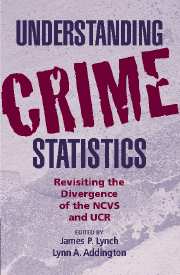Book contents
- Frontmatter
- Contents
- Acknowledgments
- Contributor Biographies
- INTRODUCTION
- OVERVIEW OF THE TWO NATIONAL MEASURES OF U.S. CRIME
- DEFINING DIVERGENCE AND CONVERGENCE
- SOURCES OF DIVERGENCE IN THE NCVS
- SOURCES OF DIVERGENCE IN THE UCR
- 8 Using NIBRS to Study Methodological Sources of Divergence Between the UCR and NCVS
- 9 Explaining the Divergence Between UCR and NCVS Aggravated Assault Trends
- 10 Missing UCR Data and Divergence of the NCVS and UCR Trends
- CONCLUSION
- Index
- CAMBRIDGE STUDIES IN CRIMINOLOGY
- References
9 - Explaining the Divergence Between UCR and NCVS Aggravated Assault Trends
Published online by Cambridge University Press: 23 December 2009
- Frontmatter
- Contents
- Acknowledgments
- Contributor Biographies
- INTRODUCTION
- OVERVIEW OF THE TWO NATIONAL MEASURES OF U.S. CRIME
- DEFINING DIVERGENCE AND CONVERGENCE
- SOURCES OF DIVERGENCE IN THE NCVS
- SOURCES OF DIVERGENCE IN THE UCR
- 8 Using NIBRS to Study Methodological Sources of Divergence Between the UCR and NCVS
- 9 Explaining the Divergence Between UCR and NCVS Aggravated Assault Trends
- 10 Missing UCR Data and Divergence of the NCVS and UCR Trends
- CONCLUSION
- Index
- CAMBRIDGE STUDIES IN CRIMINOLOGY
- References
Summary
Trends in aggravated assaults recorded by the police and those reported in victim surveys diverge over time in the United States. Police-recorded assaults trend upward during the 1980s and flatten in the 1990s, whereas survey-estimated assaults are flat during the 1980s and decline during the 1990s. Previous research has attributed the divergence between the police and survey trends to changes in police recording practices, independent of the underlying rate of victimization (Blumstein, 1998; O'Brien, 1996). This study adds to that research by comparing police and survey trends in firearm and nonfirearm aggravated assaults, on the assumption that police recording practices are more likely to affect the latter than the former. Consistent with this assumption, the results show much less divergence in gun than nongun assault time trends. Together with previous research, this study offers strong, albeit circumstantial, evidence that changes in police recording of assaults explain much of the divergence in aggravated assault trends derived from police records and victim surveys. It also appears that the NCVS redesign has helped to reduce the divergence between UCR and NCVS aggravated assault trends in recent years.
BACKGROUND AND SIGNIFICANCE
Although the United States' two major crime indicators, the FBI's Uniform Crime Reports (UCR) and the Bureau of Justice Statistics' National Crime Victimization Survey (NCVS), are based on distinct methods of obtaining information about the number and nature of criminal events, they should tell essentially the same story about changes in crime rates over time.
- Type
- Chapter
- Information
- Understanding Crime StatisticsRevisiting the Divergence of the NCVS and the UCR, pp. 251 - 268Publisher: Cambridge University PressPrint publication year: 2006
References
- 4
- Cited by

